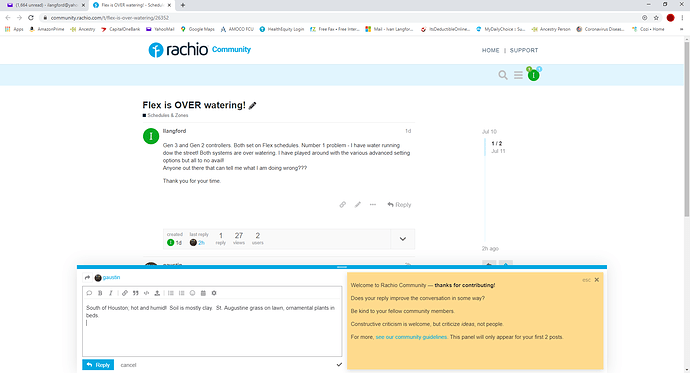It was helpful for me to think about each zone like it was a bathtub in my yard. I hope if there are mistakes in this post people will suggest improvements, because I just came up with this on my own to help me understand my system and would like to know if I am off track. Basically you tell Rachio how much water the bathtub can hold, how fast water comes out of the filler spout when you are filling it, and how fast the water in the tub normally dries up. You mark a line in the tub that you never want the water to go below. Rachio Flex keeps track of the water in the tub, and refills it to the top every time it calculates the water must have dropped to the specified low water line. It adjusts the tub contents up if rain fills your tub, and adjusts down if it is hotter than normal.
If you start with an empty tub and assuming all your valves and pipes are not leaking or broken, if water was running down the street from your bathtub you would know that either it thought the tub was bigger than it really is, or the water from the spout was coming out faster than expected. If the estimate for how fast it dries up was too high it might think the tub was emptier than it really was and so it would overflow when it tried to refill to the top after several days.
You give it this information in the basic zone setup by telling it zone plant type, spray head type, soil type, sun exposure, and slope. These simplified choices result in specific values getting filled in for the detailed list shown in the Advanced settings page. You can see the results of your choices on that Advanced setting page and customize each value if you like.
In the advanced page, you tell it how much water the bathtub can hold by setting root(tub) depth and available water. You enter all this detailed info for one emitter of tub surface area, and for purposes of whole zone calculations you tell it how many total square feet in the zone. Available water is sort of like telling it how many rocks are already in the tub taking up space so the tub does not hold as much as you think it would based on the root(tub) depth. The low water line on the tub is set by allowed depletion level. The nozzle inches per hour tells it how fast the water comes out of the spout when refilling (assuming one such nozzle/emitter for each emitter coverage area for a tub of the specified depth). One way to think of efficiency is sort of like telling it how much water splashes out of the tub when it is being filled. Lower efficiency means the water is going to have to run longer to complete the refill (and could result in some of the oversplash running down the street). It is going to figure out how fast the tub dries out using daily evapotranspiration rates from a weather source, and crop coefficient tells it how much of that daily ET to consider for this specific zone/plant/sun situation.
To make sure your Flex schedule considers the latest details you have entered, you should probably uncheck the zone to exclude it from the Flex schedule, save the schedule, and then add it back when you make changes. If you look at zone run times under the flex schedule it will then show you how many minutes it thinks it needs to run (at the specified nozzle rate) to fill the zone tub to the top. If it starts empty, it will run long enough to fill the specified tub all the way from the bottom to the top. If it is a standard refill, it will only run long enough for it to fill from the low water mark to the top. (You can force it to assume it is starting full or empty but not in between.) It is not going to use the total square footage to determine the run time, it determines the run time for each emitter coverage area of tub surface area assuming there is a nozzle in each one and they are all going at the same time. It uses the total square footage you enter to report the total water usage for the zone for the number of minutes run once the run is complete. (I think default emitter coverage area for a drip emitter is a one-foot radius circle, but as long as you have consistent assumptions throughout for coverage area and total square footage I think this can be varied.)
To figure out why water is running down the street, you want to figure out whether it thinks the tub was empty when it was actually already completely or partially full, is bigger than it really is, or if the nozzle filling rate is actually higher than it thinks, or if it is refilling too often because it dries out more slowly than it expects, or possibly that the soil type, slope, and efficiency are implying that the water can be absorbed more quickly than it actually does. If all of these things are set at a reasonably accurate level the calculations do a very good job of keeping the tub properly topped up, although it may take some time to adjust to the pattern of longer run times that repeat less frequently (probably for both plants and people). There are some great resources in this forum and the help area that show you how raising and lowering values in the advanced settings will affect how often a zone needs to refill and how many minutes of run time it takes to refill it each time, which is really all the Flex schedule is doing.



